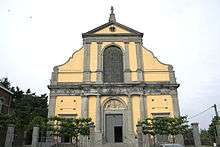Basilica of Our Lady of Tongre
| Minor Basilica of Our Lady of Tongre Notre Damé du Tongre | |
|---|---|
 | |
| Basic information | |
| Location |
|
| Geographic coordinates | 50°34′53.9″N 3°46′31.58″E / 50.581639°N 3.7754389°ECoordinates: 50°34′53.9″N 3°46′31.58″E / 50.581639°N 3.7754389°E |
| Affiliation | Roman Catholic |
| Ecclesiastical or organizational status | Minor basilica, Parish |
| Website | |
| Architectural description | |
| Architect(s) | J.F. Demarbaix |
| Architectural type | Church |
| Architectural style | Baroque |
| Completed | 1777[1] |
| Specifications | |
| Direction of façade | SW |
| Length | 60 metres (200 ft) |
| Width | 20 metres (66 ft) |
The Basilica of Our Lady of Tongre (French: Basilique de Notre Dame de Tongre) is a Roman Catholic parish church and Minor basilica in Tongre-Notre-Dame, Chièvres, Belgium. The shrine is considerably small, yet rich in historical significance.
The shrine is known for its seated image of the Madonna and Child, along with its collection of various jewels donated by various Belgian royalty, as the image was granted a Canonical Coronation via an Apostolic Brief by the Pope Leo XIII on 8 September 1881 carried out by Bishop Isidore Rousseaux.
The image is not the same as the Our Lady of Tongeren, Virgin of Joy that was Canonically crowned by the Rosary Pope in 1890 at the Tongeren Basilica, where the national feasts are widely held every seven years in all of Belgium.
Legend
On February 1, 1081, a certain Hector, the local lord, sees an apparition of the Virgin Mary in his garden. An hour later, there is nothing left of the image because the village priest, Tongre (today known as Tongre-Saint-Martin), placed it in his church.
But the next day the image of Onze-Lieve-Vrouw (Our Lady) mysteriously appears in the garden again, again shrouded in light and music. The wonder reproduced itself twice. The lord consults with the Bishop of Kamerijk, Gerald II, which, after investigation, allowed the image to be worshipped. He built a chapel in the place of these extraordinary events with the miraculous image of the Virgin Mary and it was since known as Our Lady of Tongre (Onze Lieve Vrouw van Tongre).
In his book dedicated to the pilgrimage site of Tongre-Notre-Dame, 17th century historian Father Huart [2] describes the apparition of the station of the Virgin Mary:
| “ | The miraculous apparition of the statue of Notre-Dame de Tongre was visibly brought by angels through a white, bright cloud into the gardens of the castle of Sir Hector, Lord of the place, at about 11 o’clock in the evening of the first day of February, in the year 1081 | ” |
History

A chapel was erected on 27 March 1081. In 1093, Pope Urban II established the brotherhood of Our Lady of Tongre. The place immediately attracted large numbers of pilgrims, especially as evidence of wonders and favors bestowed by Virgin Mary beginning to circulate. In the 13th century, the original chapel was replaced by a Gothic church.
In 1642, Head Abbott Georges Huart, the parish's pastor, wrote an admirable history of the Tongre-Notre-Dame which described an admirable number of wonders. They are not entirely credible but the books shows the fervour surrounding the sanctuary of Onze-Lieve-Vrouw of Tongre.
Several important people searched for the sanctuary and knelt before the Onze Lieve Vrouw van Tongre, including: King Philip I of France, Maria Theresa of Spain and Marie Henriette of Austria(Queen of the Belgians). In homage to the Virgin Mary they gave many gifts (golden crowns, jumpers woven with gold or silver, cross relics, luxury clothing for Madonna, etc.) and during that time established the 'Schatkamer van de Basiliek' (Treasury of the Basilica).
Since the 17th century, the Marian cult expanded beyond the Southern Netherlands and Northern France. In 1777, it was decided to build a larger church. This new church was designed by the architect Demarbaix and built in Baroque style. The cult was then spread further by Belgian priests.
Pope Leo XIII crowned the image on the birthday of the Blessed Virgin Mary in 1881 while Pope Pius XII raised the sanctuary to the title of minor basilica in 25 April 1951, the document was executed by the Chancellor of Apostolic Dataria, Father Gildo Brugnola.
Marian Cult and Worship
The most important feast of Onze-Lieve-Vrouw of Tongre is February 2, more precisely on the night of the 1st or 2 February, the anniversary of the appearance in the garden of Sir Hector. Accompanied by a torchlight, the statue is carried through the Maiden Tower, a circuit was established by Gerald II, bishop of Kamerijk, on February 17, 1081. The pilgrims visit the basilica the entire year, where diverse activities are organized.
The month of September is a month of special devotion. The second procession includes groups of the Sunday of September. Onze Lieve Vrouw of Tongre is revered as a 'liefdevolle moeder' (loving mother). She is the patron saint of dysfunctional families and injuries. She is also called upon by poets, writers and students.
Notes
- ↑ Mardaga, Pierre (1988), Le patrimoine monumental de la Belgique (in French), 13, Editions Mardaga, pp. 617–618, ISBN 2-8021-0086-6
- ↑ Huart 1662, p. 11
References
- Huart, George (1662), L'histoire admirable de Nostre-Dame de Tongre: avec ses principaux miracles (in French)
External links
- (French) Website van de Basiliek van Onze-Lieve-Vrouw van Tongre
- (French) Het boek Geschiedenis bewonderenswaardige Tongre-Notre Dame uit 1662